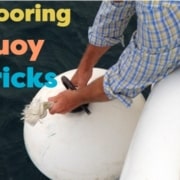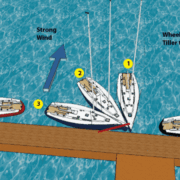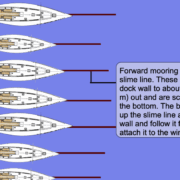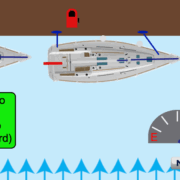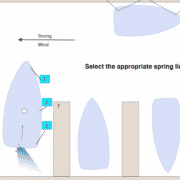How to Pick Up a Mooring Ball
Picking up a mooring ball can be tricky when you have high freeboard or doing it short or single-handed
While lying on my stomach and stretching over the front of our high freeboard catamaran with a boat hook trying to pick up a mooring ball in Les Anses D’ Arlet, Martinique, I decided there has to be a better way. Especially since here in this part of the Southern Caribbean, they don’t attach a yucky slimy line to the mooring ball that you catch with a boat hook. There is only the steal loop in the top of the ball. It’s just impossible to lift the mooring ball with the boat hook and I simply could not reach down that far to loop a line through it. What to do?
A few options I thought of immediately was to send a crew member out in a dinghy or even more fun – to jump in and swim it.
Still, there is a better way with so much less effort. And here it is below in the animation. This works for boats that have a stern swim platform where you can reach easy down to the floating mooring ball. This also works great if you are doing a mooring pick-up single-handed.
Click the “Moor the Boat” button.
The principle is simple – motor downwind past your selected mooring ball and back up to it. Run a line from the forward cleat outside the stantions and shrouds. Then run the free end through the pendant of the mooring ball and then run it back forward to the same forward cleat. You can let the boat swing around by itself or you can assist with the engine or you can even pull on the line a little harder to assist the mooring ball move towards the front of the boat. Once the boat has swung around with the bow facing to wind, you can adjust the mooring line to your desired length – if the wind is blowing hard you can use the engine to move the boat to windward.
You can also do this maneuver by backing downwind and bringing the mooring ball to the side stern stopping the boat long enough to run the line through – then continue backing down while a crew member walks the mooring ball and line forward. We don’t really recommend this because having your bow facing to the wind is a very unstable way to be backing and controlling your boat. Rather, having your stern to face the wind is much more stable – especially in high winds. Thus only back downwind in very light conditions.
Yet another way is to drive the boat forward next to the mooring ball and stop the boat when the ball is at your side stern. Loop the line from the forward cleat through the pendant, then the captain can back downwind while the crew member walks the mooring ball forward. The crew member then completes by cleating the loose end to the forward cleat.
We used this last method (which is just a variation of the animated method above) in Petit Anse and most of the other mooring fields in Martinique. Simply because it is incredibly simple but also they do not have a floating pendant line and the mooring balls themselves were too heavy to lift up the side of the boat.
There are some cautions to think about:
- Don’t have any crew members standing on the swim platform while backing the boat. When doing this with your stern to wind, you will be surprised at how long the boat remains stable at the mooring ball after you have stopped the boat which will give your crew plenty of time to get in place and loop the line through the pendant.
- Use a boat hook to draw the mooring ball towards the boat if it is out of reach.
- Keep all lines in the boat until ready at the mooring ball – not on the swim platform (don’t want them falling off and getting wrapped in the prop) this is SOP for all sailing regardless
- Make sure you are an expert at backing a boat – know how to stop the boat without backing over the mooring ball (durh). If you are not good at backing a boat, take the Maneuvering Under Power course which will have you backing like a pro.
Here are the photos doing the maneuver, but the animation tells the story better.
(1) Make a dock line that will reach to the stern whilst tied to a cleat at the bow without any knots in between.
(2) Drive the boat to bring the mooring ball to the aft of the boat next to your swim platform

Bring the mooring ball along side to the aft
(3) loop your dock line through the steel loop on the ball.
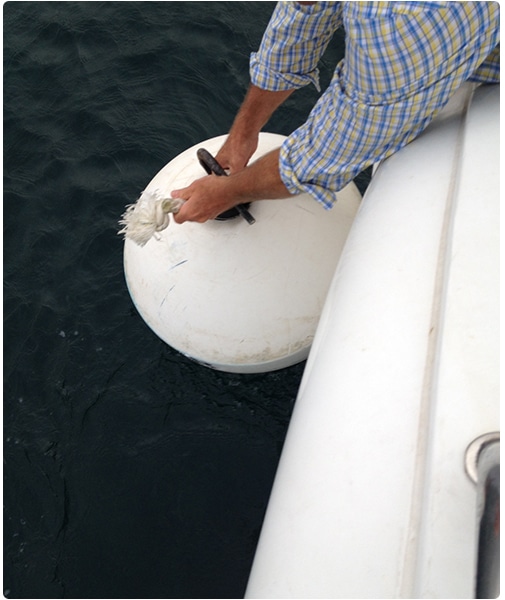
Place the Dockline through the mooring ball ring at the aft of the boat
(4) Then just walk your free end to the bow and cleat it off as the boat backs away. Initially, make sure the dock line goes around the outside of everything on your boat – lifelines, stantions and shrouds. Do the same as you walk back to the bow with the free end. The helmsperson uses the engine to keep the mooring ball close to the boat as you walk forward so that the free end does not get pulled out of your hand.
(5) On a catamaran – there is one more trick needed because the mooring lines to the ball must each run back to the same side as they start – i.e. port cleat to mooring ball and back to port cleat. Starboard cleat to mooring ball and back to starboard cleat.
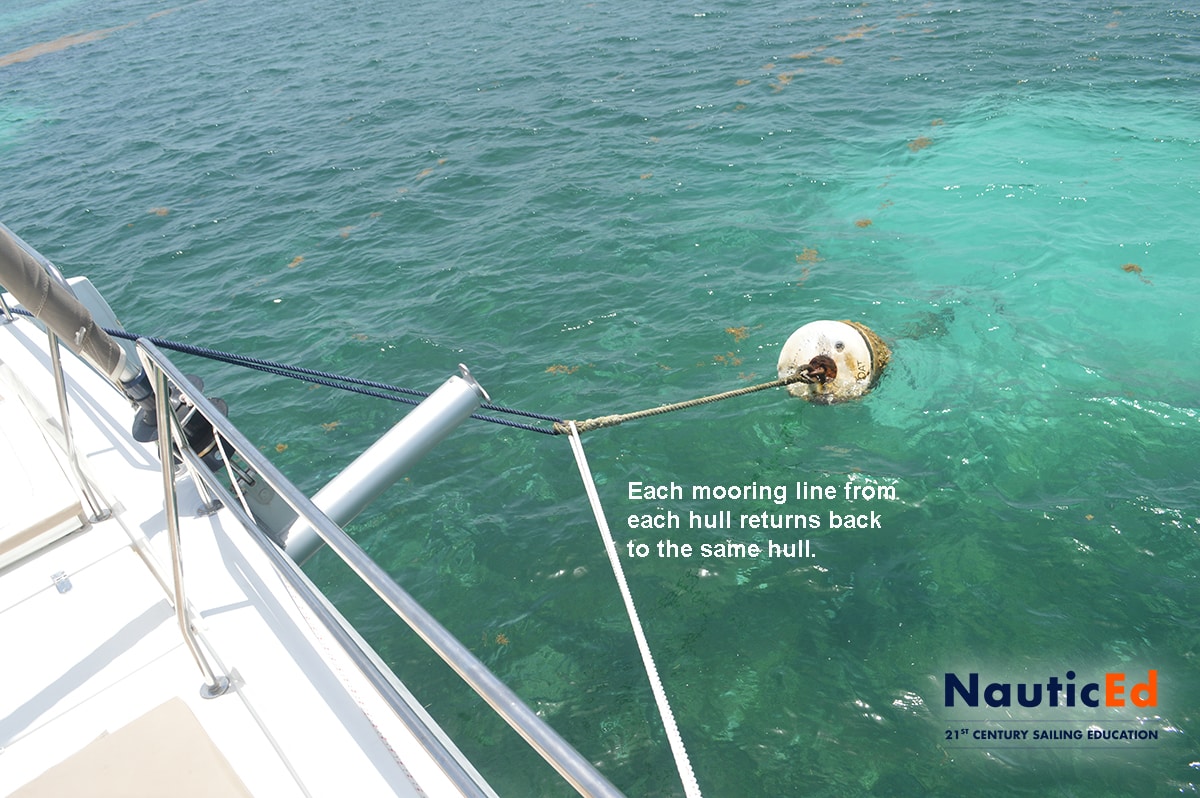
Mooring a Catamaran in Antugua
Thus, at the same time as running the first line through the pendant, run another line through the mooring ball pendant to take forward for the other hull. This can be shorter and does not need to be cleated yet to the other side of the boat (it is doubtful that you would have a line this long). However, be careful to not drop any of the ends of the second line. Secure the free end of the first line to the forward cleat. Now you can relax and take your time maneuvering to get the second mooring line across to the other forward cleat on the other side. The captain can assist by maneuvering the boat with the dual engines.
It’s best done with two crew members one assigned to each line and a helmsperson who can maneuver the boat to keep the ball close to the boat. The second dockline will probably not reach from the forward cleat diametrically opposite the boat to the aft – that’s ok just leave both ends free and cleat them off once the first line is done. Just take care not to drop either end (we did but quickly retrieved it with a boat hook).
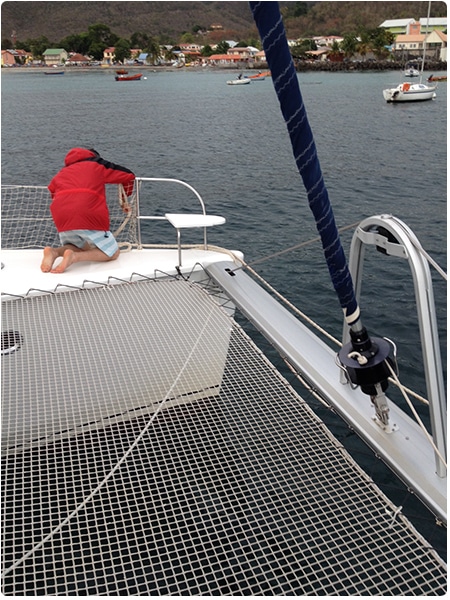
Secure the Line to the other side of the boat using the second dock line.
(7) Finally make adjustments to the lengths to get it just right.
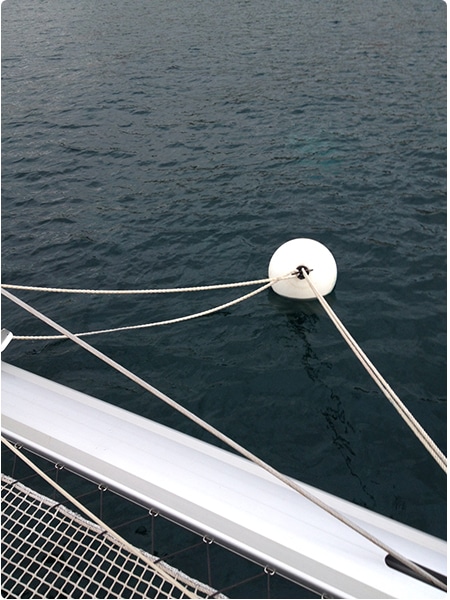
Adjust Lines to get it just right
Train your crew to let go of the dock line if it gets too taught and is going to pull them over. You can always start again. Practice makes perfect.
In Blue Lagoon, St. Vincent the Mooring field is quite tight. We used this trick again without a hitch. Practice this method at your home waterway next time you are out. Then by the time you yacht chartering to the Caribbean, Pacific, or Mediterranean, you’ll be an expert.
For this and many other tricks and tips on making your sailing adventures and yacht charters more fun, take the NauticEd Bareboat Charter Master bundle of courses.
Wanting a Sailing License for the Mediterranean? Check out the NauticEd SLC – accepted by port authorities and yacht charter companies, worldwide!

The more you learn, the greater is life’s adventure!
If you like this post – please LIKE it via facebook it – thanks it helps us grow
Next up? Check out our sweet-as anchoring trick – how to turn your boat into the waves at anchor rather than the wind to get a comfortable night’s sleep


